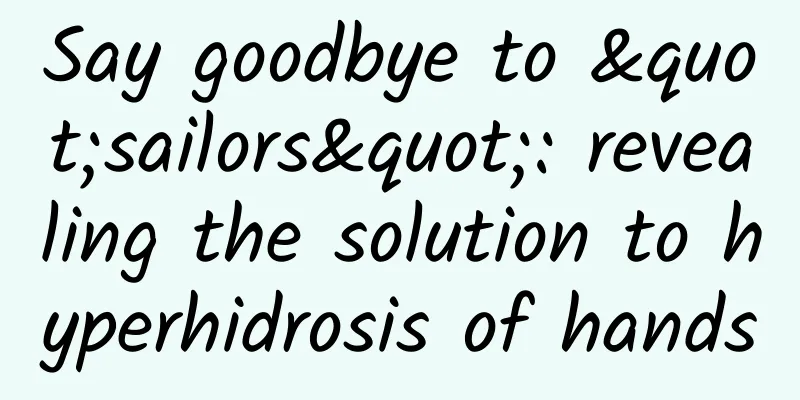Say goodbye to "sailors": revealing the solution to hyperhidrosis of hands

|
Author: Liu Yanguo, Chief Physician, Peking University People's Hospital Reviewer: Shi Wenzai, attending physician at Peking University International Hospital Sweating, as a natural physiological regulation mechanism of the human body, is essential for maintaining a constant body temperature. However, for some people, excessive sweating of the palms has become a problem, seriously affecting their daily quality of life. We call this condition "hyperhidrosis of the palms". 1. Causes and characteristics of hyperhidrosis of hands Hyperhidrosis of the hands, as the name suggests, refers to the phenomenon of abnormal sweating of the hands. The palms of the patient will sweat frequently and profusely when they are emotionally tense or in a hot environment. In severe cases, water droplets may form, which will affect basic activities such as writing, using electronic devices, and social handshakes, causing great trouble to the patient's life. The results of epidemiological surveys in my country show that the prevalence rate is about 2%. Figure 1 Original copyright image, no permission to reprint Hyperhidrosis of the hands is mainly a congenital disease, and its pathogenesis is closely related to genetic factors. Patients usually have symptoms of excessive sweating in the palms since childhood. It is worth noting that although hyperhidrosis of the hands has a certain genetic tendency, it is not a hereditary disease, and its inheritance probability is about 30%. In addition, the diagnosis of hyperhidrosis of the hands is mainly based on subjective feelings, that is, the pain caused to the patient by continuous and heavy sweating of the palms, and the patient's willingness to actively seek treatment, rather than specific objective indicators. Environmental factors can also have a certain impact on the clinical manifestations of hyperhidrosis. For example, when patients are nervous, hot, or engaged in physical or mental activities, the amount of sweating will increase significantly. When patients with hyperhidrosis sleep at night, their palms are usually dry; and in a calm state during the day, sweating may also decrease or disappear. Treatment of hyperhidrosis of hands Traditional treatments for hyperhidrosis include oral medications, topical astringents or corrosives, and botulinum toxin injections, but the therapeutic effects of these methods are often limited and short-lived. Currently, thoracic sympathectomy under thoracoscopic surgery is considered to be the most effective method for treating hyperhidrosis. This surgery reduces palmar sweating by cutting off the sympathetic nerve branches that innervate the sweat glands in the palms. Specifically, the operation will make a small incision of about 5-10 mm in the patient's armpit, use a thoracoscope to enter the chest cavity, and accurately cut the target nerve. If everything goes well, the single-sided operation time is about 5-10 minutes, and the total duration of bilateral surgery is no more than 20 minutes. The patient is under general anesthesia during the operation, so he will not feel any discomfort. Figure 2 Original copyright image, no permission to reprint However, surgical treatment is not suitable for all patients. Surgery for hyperhidrosis is usually suitable for patients with moderate to severe hand sweating, that is, people whose hand sweating seriously affects their daily life. This type of surgery is not recommended for patients who have had pleurisy, tuberculosis or severe pneumonia that has caused pleural adhesions, and for patients with significant bradycardia, because these conditions increase the risk of surgery. 3. Postoperative Condition The effectiveness of surgery for hyperhidrosis of the hands can reach 95%-100%. Patients may experience a short period of pain after surgery, especially in the wound and back area, but this pain can usually be relieved by appropriate analgesics and gradually decreases until it disappears within a week. A common side effect that may occur after surgery is increased sweating in other parts of the body, such as the chest and back, and the extent of this phenomenon varies from person to person. Depending on the specific method of surgery, that is, the different parts of the sympathetic nerves that are cut (T3 or T4), the postoperative effects will also be different. T3 cutting will lead to drier palms, but its side effects are relatively large; T4 cutting has milder side effects, but some patients still have sweaty palms after surgery. Patients can make personalized choices based on doctor's advice and personal preferences. |
>>: How to take care of appendicitis after surgery? Start with the wound, activities, and diet!
Recommend
Why do girls have body odor?
When it comes to men, many women call them stinky...
What are some practical gifts for Teacher's Day? How to give gifts to teachers so that they will accept them?
Every time when Teacher's Day comes, students...
What are the symptoms of vulvar warts?
Due to the lack of medical knowledge, most people...
What should I do if my breasts sag after breastfeeding?
Now, more and more women are experiencing sagging...
How to deal with white spots in women's private parts
As a skin disease, white spots require different ...
6 kinds of food that the kidneys are afraid of. Many people eat them almost every day, but they don’t know
The kidney is a very important "filter"...
Pay attention to the sequelae of accessory breast removal after reading this!
After accessory breasts appear, many people will ...
Can women eat longan during menstruation?
Longan is a fruit with extremely high nutritional...
There is a group of children who are like stars shining alone in the night sky.
April 2, 2025 It is the 18th World Autism Day Thi...
Pregnant women have back pain after sitting for a long time
As pregnant women get older, they are less willin...
The error rate of Xiuer's early pregnancy
Although early pregnancy test strips can accurate...
Ectopic pregnancy hcg high or low
The hcg test cannot determine whether it is an ec...
my country's new coronavirus special medicine may produce another "dark horse" that can prevent mutant strains!
0.6 grams of antibody per injection, one injectio...
Women can't hold their urine recently
What is the reason why women can’t hold their uri...








![[Meet a rising star] How to scientifically supplement vitamin D for children?](/upload/images/67f207d63cd7a.webp)
